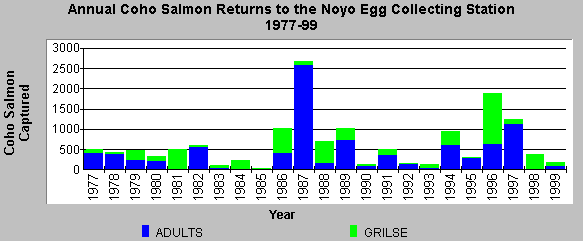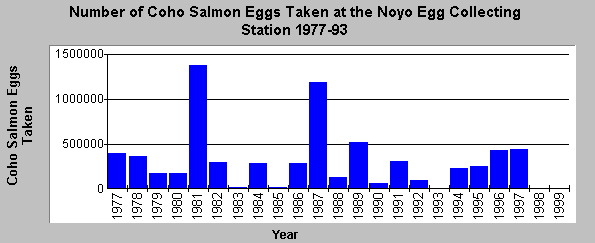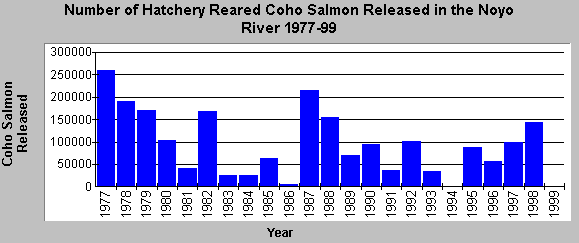
|

|
| Background | Hypotheses | Bibliography | Maps | Home |

|

|
| Background | Hypotheses | Bibliography | Maps | Home |
KRIS Web Background Pages: Hatcheries
![]()
The Noyo River Egg Collecting Station, operated by the California Department of Fish and Game (CDFG), is located in Jackson Demonstration State Forest on the South Fork Noyo River. It is the only fish culture facility in California that has focused exclusively on coho salmon. Hatchery information in KRIS Noyo is based on hatchery reports (Sanders, 1978,1980,1982,1983; Grass, 1981,1983, 1988,1989-1993; Poe,1984,1987) and personal communications with Alan Grass, Fish Culturist, Region 3 CDFG.
The facility has had adult coho returns numbering over the years from 16 to 2560. Low returns may pose a problem for maintaining genetic diversity. The National Marine Fisheries Service (1987) noted that a minimum of 200 adults is required for preserving fitness of a hatchery population. A mitigating factor is that coho salmon do spawn outside the hatchery and fish are passed upstream to spawn even when the station is operating the trapping weir. In drought years such as 1990, most fish spawned downstream of the hatchery because of insufficient flows.

The chart above shows a highly variable return of adult and grilse coho salmon to the Noyo Egg Taking Facility from 1977 to 1999. Grilse are precocious males that return after just one year at sea while adults are larger, having spent two years in the ocean.
The Noyo Egg Taking Facility sacrifices grilse, coho salmon that return after just one year in the ocean. The grilse are not used for broodstock nor allowed to spawn naturally in the stream. This does not conform to recommended brood handling practices for small hatcheries (Hard et al., 1992). Since grilse dominate returns in some years, not using them as brood fish compounds problems with maintaining genetic diversity. It is possible that timing and size of release of juvenile salmon may be the determining factor that causes such a high rate of early spawning returns from the ocean (Hankin, 1985).

Above: The number of coho salmon eggs collected from the Noyo River Egg Taking Facility from 1973 to 1999 has varied considerably from a high of 1,381,755 to a low of 4,500.
The number of coho salmon eggs collected since 1973 has ranged between 4500 and 1,381,755. Female coho have had an average of about 2200 eggs. Eggs collected at the Noyo facility are shipped to Mad River Hatchery for hatching and rearing, and then back to the Noyo River for planting. Formerly, eggs were also shipped to the Silverado fish rearing site and Warm Springs Hatchery. Transfer of Noyo River coho to Warms Springs Hatchery was discontinued because of disease concerns in the 1990s (See Fish Diseases).

The chart above shows the number of smolts released into the South Fork Noyo River, by year, from 1973 to 1999.
The number of coho salmon juveniles planted has varied from 5000 to over 214,000. Fish are usually released in the South Fork Noyo during March, after being acclimatized in holding ponds at the Noyo Egg Taking Station. In years of large plants, the possibility of competition with wild fish exists, particularly if flows are low. Hatchery-reared fish may have a competitive advantage because of larger size.
The Noyo fish culture station for coho salmon supplemented its broodstock in years of low escapement in the 1970s with eggs from the Alsea River in Oregon and the Washougal River in Washington (as documented in CDFG transfer permits). Noyo coho have subsequently been transplanted to almost all Mendocino county coastal streams, Mad River Hatchery, and Prairie Creek Hatchery, and are the origin of the broodstock at Warm Springs Hatchery on the Russian River (Higgins et al, 1992). Studies of coho salmon in Mendocino County streams show that native alleles are very rare, probably as a result of gradual hybridization following stock transfers (Jennifer Nielsen, personal communication). Higgins et al. (1992) noted that stock transfers were probably counter-productive to survival of wild populations of salmon and steelhead in the region.
![]()
References
Grass, A. 1981,1983,1988,1989-1993. Annual Report Noyo River Egg Collecting Station (various years). California Department of Fish and Game, Region 3, Inland Fisheries.
Hankin, D.K., 1985, Analysis of recovery data from fall chinook salmon released from Iron Gate Hatchery and Trinity River Hatchery, and implications for management of wild and hatchery chinook salmon stocks in the Klamath River system. Contract with USDI, Bureau of Indian Affairs, Northern California, Hoopa, CA, 117 p.
Hard, J.J., R.P. Jones, Jr., M.R. Delarm, and R.S. Waples, 1992, Pacific salmon and artificial propagation under the Endangered Species Act. US Department of Commerce, National Marine Fisheries Service, Technical Memorandum NMFS-NWFSC-2, Seattle, WA.
Higgins, P., S. Dobush and D. Fuller, 1992, Factors in northern California threatening stocks with extinction. Prepared for the Humboldt Chapter American Fisheries Society, Arcata, CA, 26 p.
National Marine Fisheries Service. 1987. Endangered and threatened species, winter run chinook salmon. Federal Register 52: 604 I-6048.
Nielsen, Jennifer, personal communication. Genetic researcher at Stanford's Hopkins Marine Laboratory, Moss Landing, CA.
Poe, S.D. 1984,1987. Annual Report Noyo River Egg Collecting Station (various years). California Department of Fish and Game, Region 3, Inland Fisheries.
Sanders, S.W. 1978,1980,1982,1983. Annual Report Noyo River Egg Collecting Station (various years). California Department of Fish and Game, Region 3, Inland Fisheries.
![]()
| www.krisweb.com |